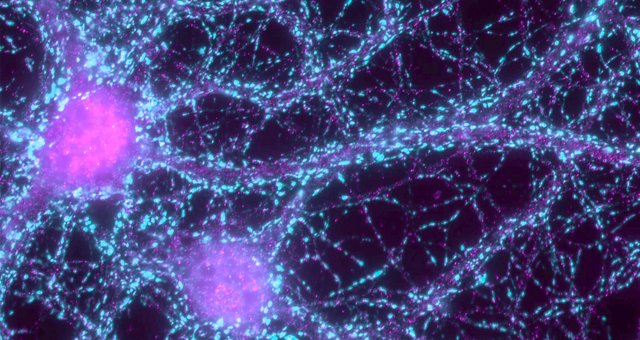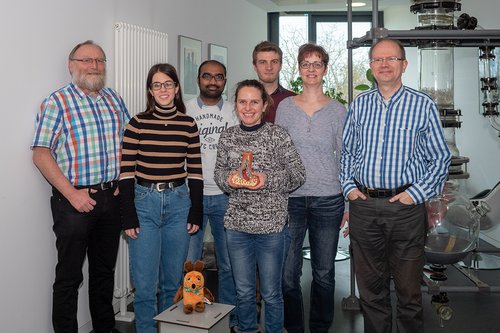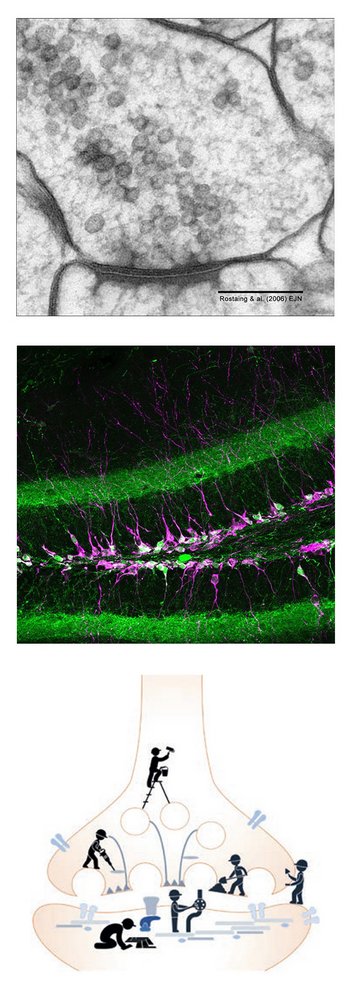Chemical Synapses
The communication between nerve cells in the brain takes place primarily at specific contact points, the chemical synapses. The release of neurotransmitters on the presynaptic side and their detection on the postsynaptic side are central processes of synaptic signal transduction. These processes are executed by complex molecular machines that consist of several hundred proteins. The enormous capacity of our brain is based on the dynamic regulation of these molecular machines. The variability in the strength of synaptic transmission, i.e., the synaptic plasticity, constitutes the basis for learning and memory. The research of the working group deals with certain aspects of the synaptic function:
- the regulation of neurotransmitter release in the active zone
- the dynamics of chemical synapses in learning and disease processes
- Head
Head
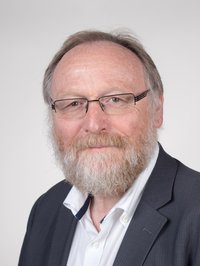
Eckart D. Gundelfinger (PhD) is the head of the department and since 2010 acts as managing scientific director of the LIN. He is also appointed as Professor of Molecular Neurobiology at the Otto von Guericke University, Medical Faculty in Magdeburg and one of the spokespersons of the Center for Behavioral Brain Sciences (CBBS) Magdeburg. He studied Biology at the University of Stuttgart, performed research for his doctoral thesis at the May Planck Institute for Biology in Tübingen and spent two years as postdoctoral EMBO fellow at the EMBL in Heidelberg. In 1984, he started his research on molecular mechanisms of brain synapses, first as a staff scientist at the Center for Molecular Biology of the University of Heidelberg (ZMBH, with Heinrich Betz) and from 1988 in his own group at the Center for Molecular Neurobiology in Hamburg (ZMNH). Since 1992 he heads the Dept. of Neurochemistry and Molecular Biology at the LIN. Current research is focused on molecular mechanisms of synaptic plasticity underlying learning and memory and on disease mechanisms of synapthopathies.
- Members
Members
Head Gundelfinger, Prof. Dr. Eckart D. +49-391-6263-92421, 93311 eckart.gundelfinger@lin-magdeburg.de Secretary Martina Rabe +49-391-6263-93311 mrabe@lin-magdeburg.de Postdocs Dr. Rainer Pielot +49-391-6263-93391 rainer.pielot@lin-magdeburg.de PhD students Armand Blondiaux +49-391-6263-93341 armand.blondiaux@lin-magdeburg.de Technical staff members Chris Theuerkauf +49-391-6263-94282 chris.theuerkauf@lin-magdeburg.de Guests Dr. Anil Annamneedi, CBBS LSA fellow +49-391-6263-93371 anil.annamneedi@lin-magdeburg.de Dr. Carolina Montenegro, CBBS LSA fellow +49-391-6263-93341 carolina.montenegro@lin-magdeburg.de - Projects
Projects
The release of neurotransmitters from synaptic vesicles takes place at the active zone of the presynaptic membrane. There, a highly sophisticated network of proteins – the cytomatrix at the active site or CAZ – organizes processes of regulated exocytosis of transmitter and the recycling of synaptic vesicles. Two very large scaffolding proteins – Bassoon and Piccolo – are major organizing elements of the CAZ. Since their discovery more than 25 years ago, various functions of these proteins have been reported (see Gundelfinger, Reissner & Garner, 2016). Currently, we deal with questions like:
- What role do these proteins play in processes of presynaptic plasticity and in the remodeling of the active zone? (see, e.g., Okerlund et al., 2017;Hoffmann-Conaway et al., 2020; Ivanova et al., 2020; Montenegro-Venegas et al., 2020)
- How does the loss of Bassoon at distinct synapses affect brain development and brain function, e.g. in learning and memory processes? (see, e.g., Annamneedi et al., 2018)
- What can we learn from this for human diseases? For example, mutations in the human BSN gene can lead to neurodegenerative diseases and epilepsy. A project in collaboration with the AG Extracellular Matrix investigates changes in the ECM in epileptic Bsn mouse mutants as a disease model.
Further projects that are carried out in collaboration with several other research groups of the LIN and the Otto von Guericke University (OVGU) deal with changes in the synaptic proteome – i.e., the protein composition of all related synapses – during memory formation or in inflammatory processes in the brain.- How do synapses change in cortex-dependent learning processes? Cortex-dependent learning processes produce marked changes in the synapse proteome of the mouse brain. These changes are very different in the distinct brain areas involved the process, as research in the CRC 779 has shown (Kähne et al., 2012, 2016).
- How does Toxoplasma gondii infection affect brain synapses?T. gondii is a eukaryotic parasite that infects about 30-50% of humans. In infected mice, chronic infection with the parasite causes significant changes in the synaptic proteome. As demonstrated by a study initiated by Ildiko Dunay (OVGU) signaling pathways responsible for learning & memory and synaptic plasticity are down-regulated and inflammation-associated markers are highly up-regulated in infected brains (Lang et al., 2018).
- Selected Publications
Selected Publications
Annamneedi A, Caliskan G, Muller S, Montag D, Budinger E, Angenstein F, Fejtova A, Tischmeyer W, Gundelfinger ED, Stork O (2018) Ablation of the presynaptic organizer Bassoon in excitatory neurons retards dentate gyrus maturation and enhances learning performance. Brain Struct Funct (PMID: 29915867)
Gundelfinger ED, Reissner C, Garner CC (2016) Role of Bassoon and Piccolo in Assembly and Molecular Organization of the Active Zone. Front Synaptic Neurosci 7:19Hoffmann-Conaway S, Brockmann MM, Schneider K, Annamneedi A, Rahman KA, Bruns C, Textoris-Taube K, Trimbuch T, Smalla K-H, Rosenmund C, Gundelfinger ED, Garner CC, Montenegro-Venegas C. 2020. Parkin contributes to synaptic vesicle autophagy in Bassoon-deficient mice. eLife. 9:1-30. https://doi.org/10.7554/eLife.56590
Ivanova D, Imig C, Camacho M, Reinhold A, Guhathakurta D, Montenegro-Venegas C, Cousin MA, Gundelfinger ED, Rosenmund C, Cooper B, Fejtova A. 2020. CtBP1-Mediated Membrane Fission Contributes to Effective Recycling of Synaptic Vesicles. Cell Reports. 30(7):2444-2459.e7. https://doi.org/10.1016/j.celrep.2020.01.079
Kähne T, Kolodziej A, Smalla KH, Eisenschmidt E, Haus UU, Weismantel R, Kropf S, Wetzel W, Ohl FW, Tischmeyer W, Naumann M, Gundelfinger ED (2012) Synaptic proteome changes in mouse brain regions upon auditory discrimination learning. Proteomics 12:2433-2444
Kähne T, Richter S, Kolodziej A, Smalla KH, Pielot R, Engler A, Ohl FW, Dieterich DC, Seidenbecher C, Tischmeyer W, Naumann M, Gundelfinger ED (2016) Proteome rearrangements after auditory learning: high-resolution profiling of synapse-enriched protein fractions from mouse brain. J Neurochem 138:124-138
Lang D, Schott BH, van Ham M, Morton L, Kulikovskaja L, Herrera-Molina R, Pielot R, Klawonn F, Montag D, Jansch L, Gundelfinger ED, Smalla KH, Dunay IR (2018) Chronic Toxoplasma infection is associated with distinct alterations in the synaptic protein composition.J Neuroinflamm 15: 21Montenegro-Venegas C, Fienko S, Anni D, Pina-Fernández E, Frischknecht R, Fejtova A. 2020. Bassoon inhibits proteasome activity via interaction with PSMB4. Cell Mol Life Sci. doi: 10.1007/s00018-020-03590-z. Online ahead of print. PMID: 32651614
- Current Third Party Funds
Current Third Party Funds
2008-2019
DFG SFB 779 "Neurobiology of Motivated Behavior"
www.sfb779.de/en
2015-2018
European Commission “Innovative Training Network ECMED“
http://www.ecmed-itn.eu/
2016-2019
BMBF-FONDECYT/Chile “PrePlastic” - Cooperations
Cooperations
- Prof. Daniela Dieterich, Institut für Pharmakologie und Toxikologie, OVGU, Medicine
- Prof. Ildiko Dunay, Institut für Inflammation und Neurodegeneration, OVGU, Medicine
- Prof. Dr. Anna Fejtova, University Erlangen
- Prof. Craig Garner, DZNE, Berlin
- Prof. Thilo Kähne & Prof. Michael Naumann, Inst. Experimentelle Innere Medizin, OVGU, Medicine
- Prof. Frank Ohl, SPL/LIN
- Prof. Christian Rosenmund, Charité, Berlin
- Dr. Karl-Heinz Smalla & Dr. Wolfgang Tischmeyer, MBT/LIN
- PD Dr. Björn Schott, Genetic Imaging/LIN
- Prof. Oliver Stork, Institut für Biologie, OVGU, Natural Sciences
- Dr. Viviana Torres, Pontificia Universidad Católica de Chile, Santiago, Chile
- Prof. Pedro Zamorano, Universidad de Antofagasta, Antofagasta, Chile
- Our activities
Our activities
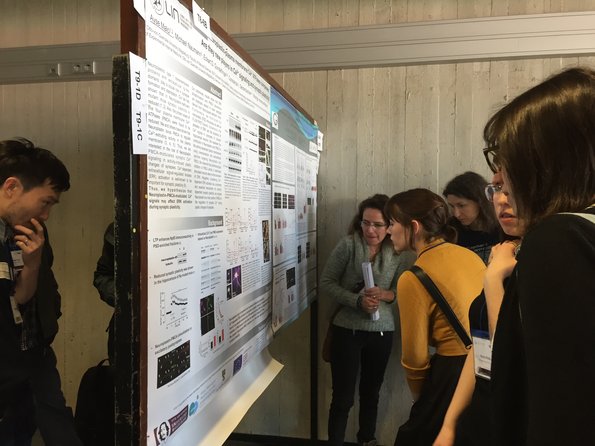
Carolina Montenegro during poster discussion at the German Neuroscience Meeting in Göttingen, 20.-23. 3. 2019 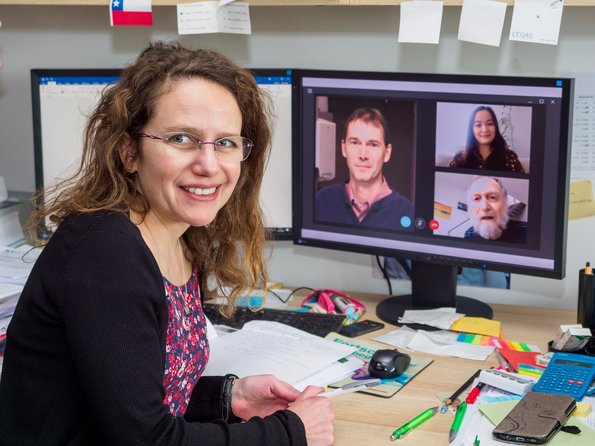
Preparation of a manuscript in times of Covid-19

